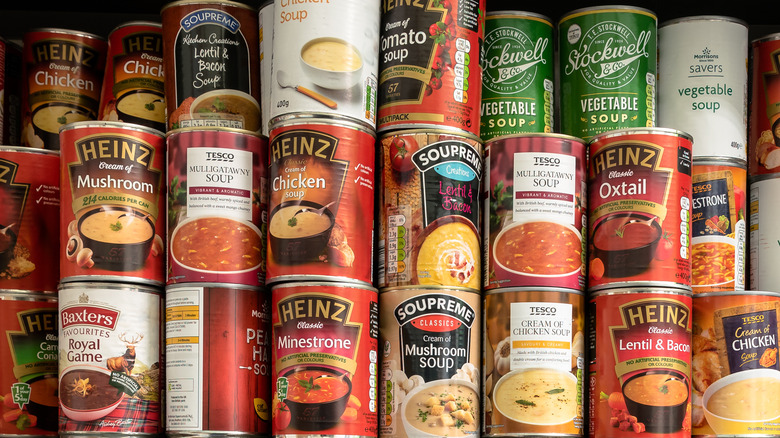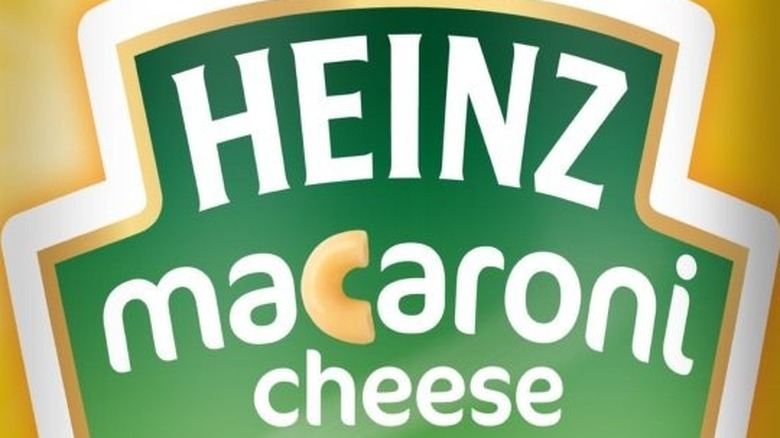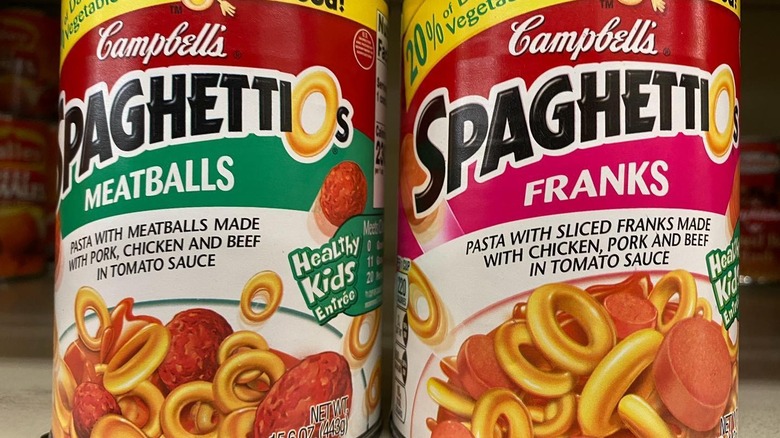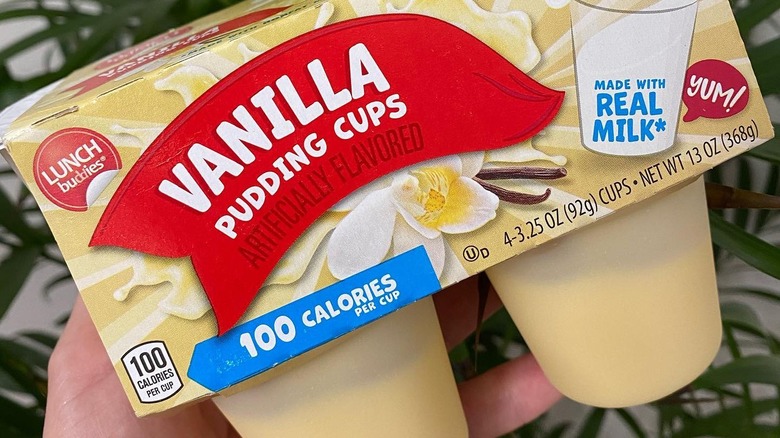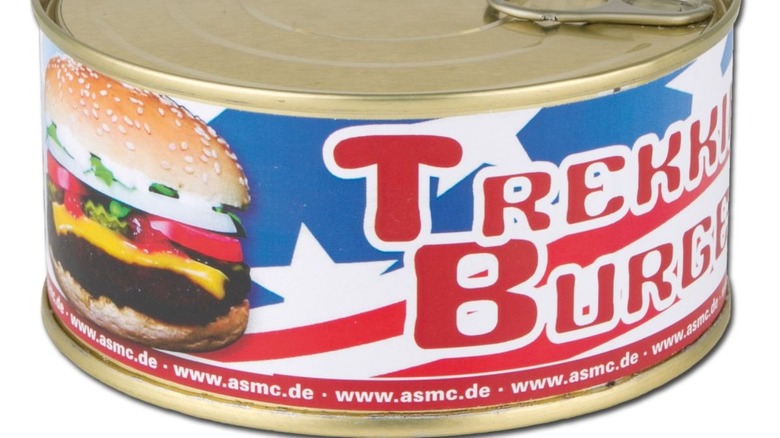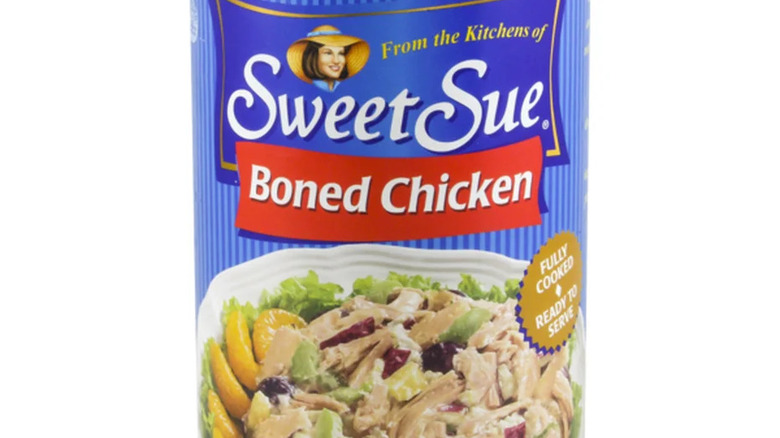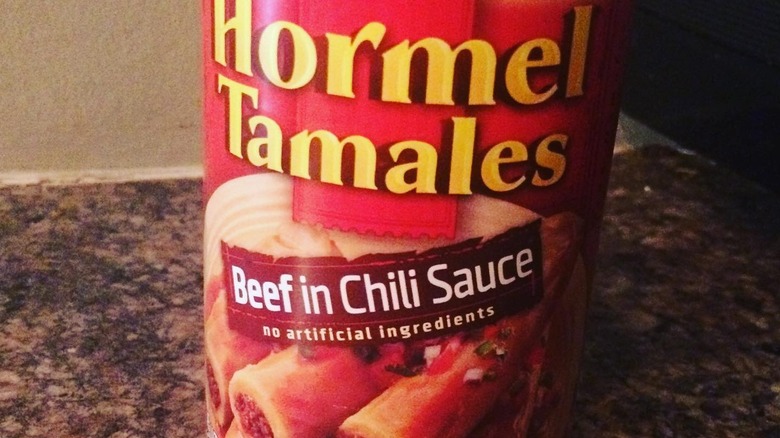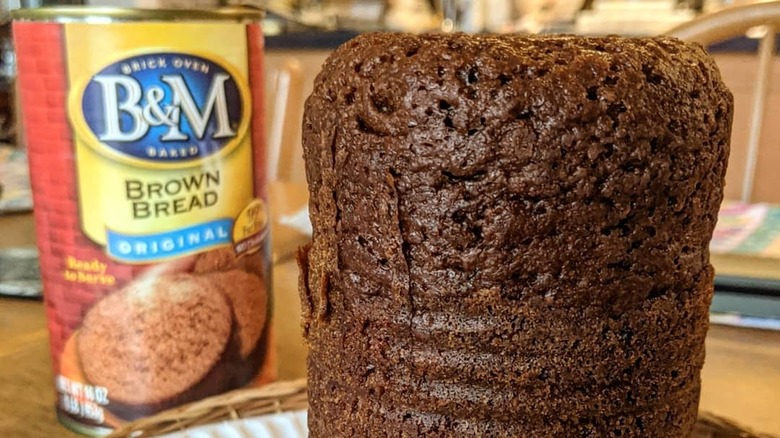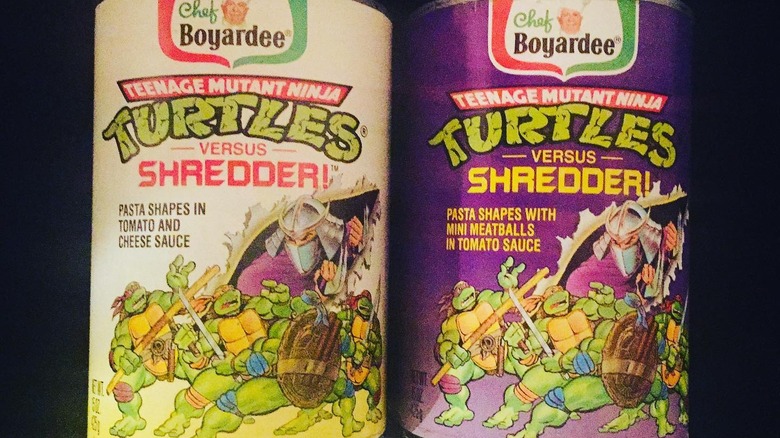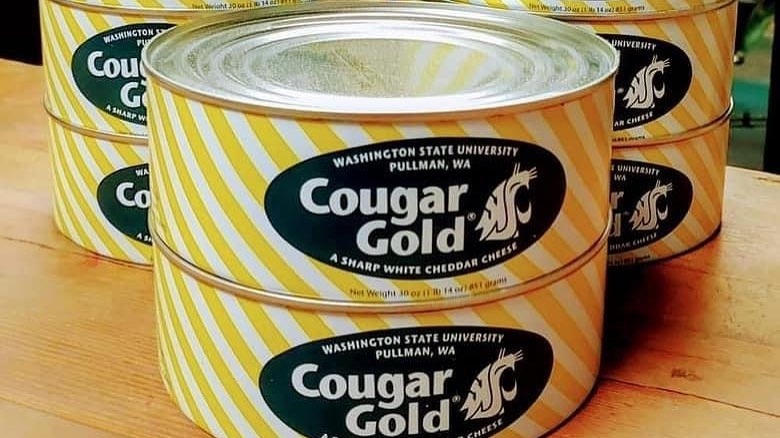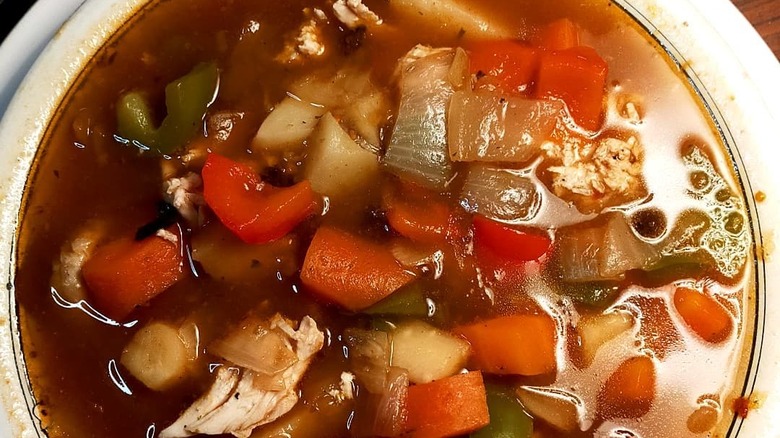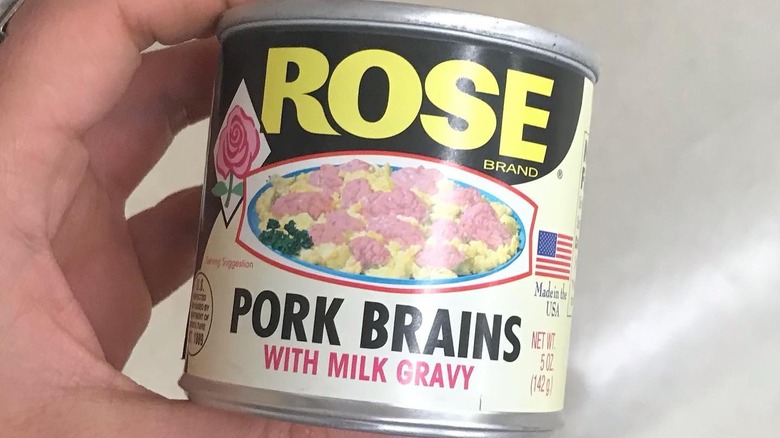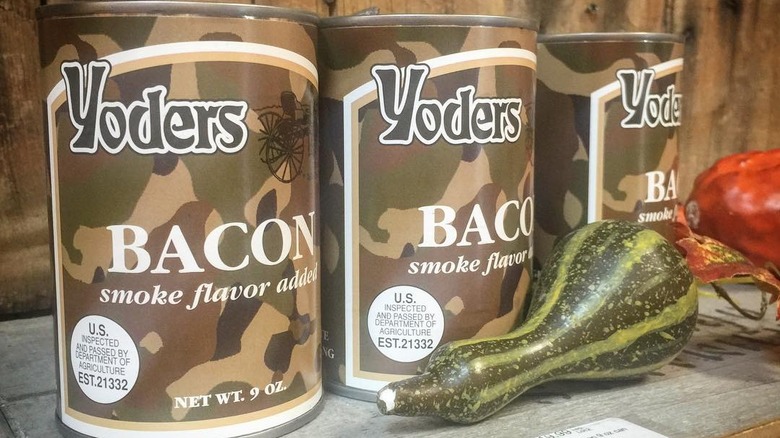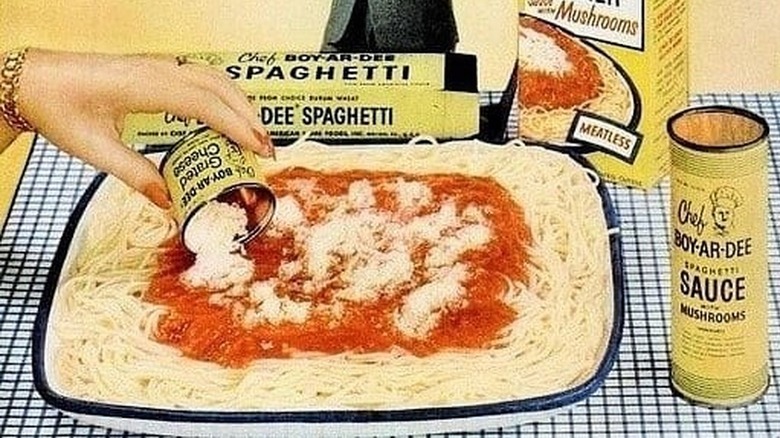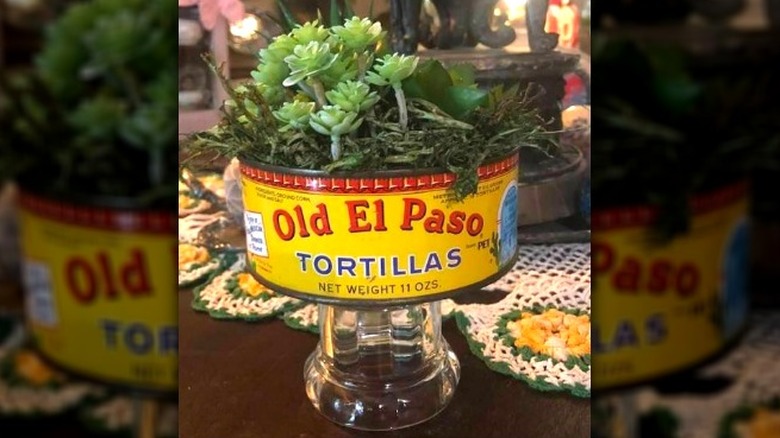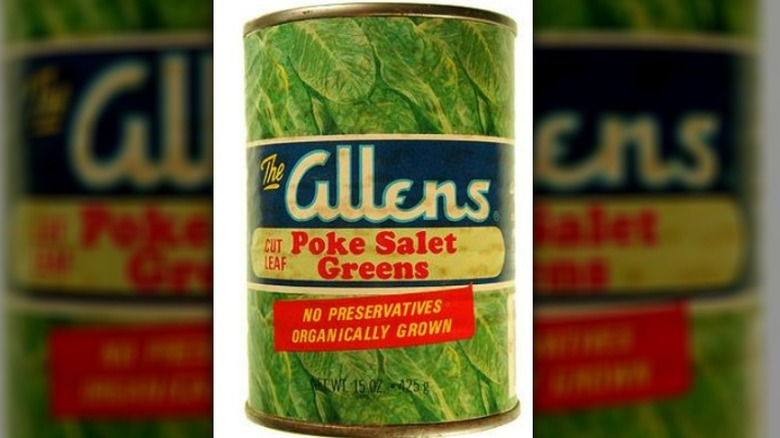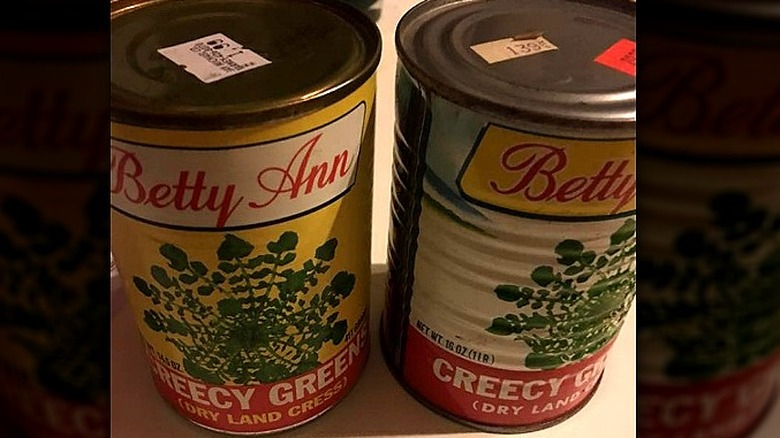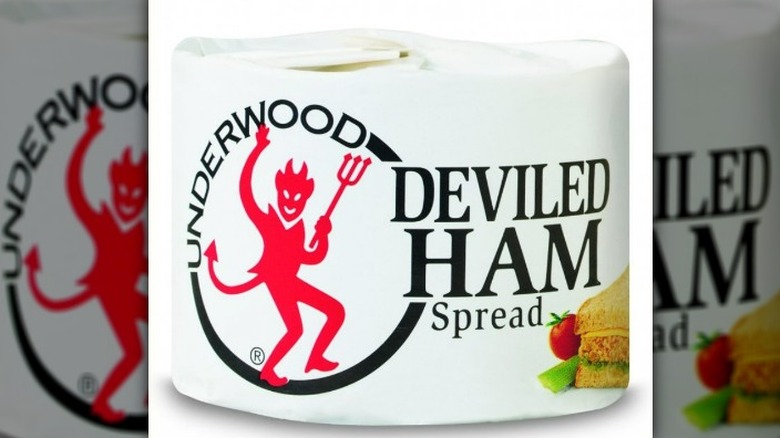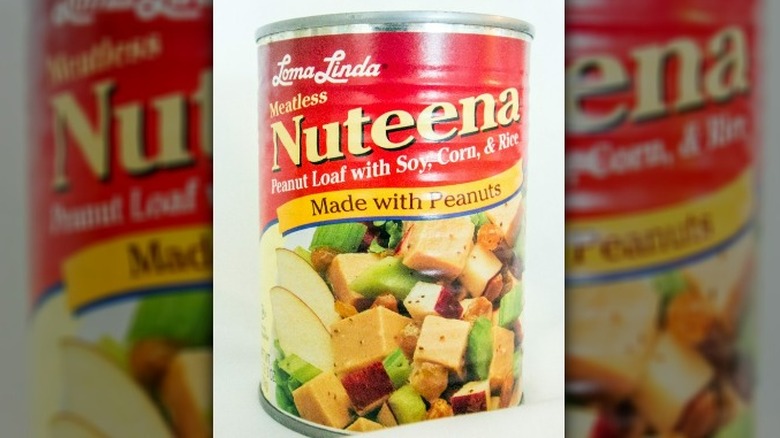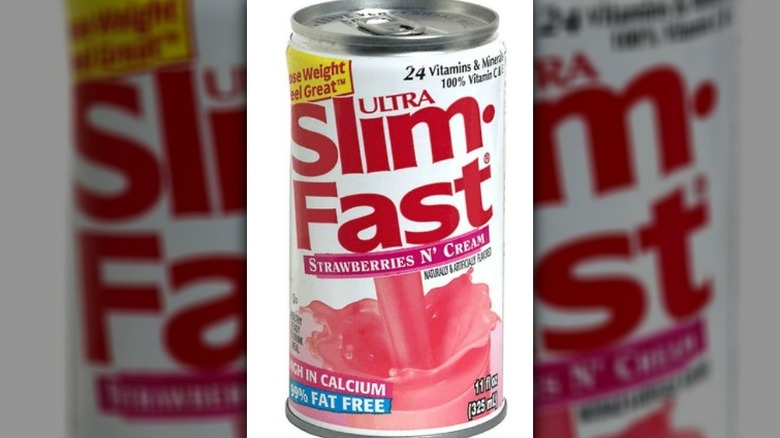Once Popular Canned Foods That No One Eats Any More
We may receive a commission on purchases made from links.
Prior to the start of the 1800s, the only options for preserving food were to pickle, salt, smoke, or dry it. This limited the types of foods that could be preserved, as well as how long they could be kept. As wars raged across Europe in the late 1700s, however, the French government decided to develop a way of shipping shelf-stable food to their soldiers and seamen — this is how canned food was born (via History). By 1810, canned food was being produced across the continent.
The canned food industry was valued at more than $91.4 billion in 2018 (via Allied Market Research). While more canned foods are sold today than ever before, anyone who lived and grocery shopped in the 1960s, '70s, '80s, and '90s knows that the 20th century produced far more odd canned foods than you'll find today. Let's take a look at some of the canned foods that were once popular in the industry's heyday.
Macaroni and cheese
It's no secret that boxed mac and cheese is a pantry staple in the U.S. In fact, nearly 9 million Americans chowed down on 5 boxes or more in 2020 (via Statista). Incredibly, macaroni and cheese has been around since the 1700s, though Kraft is credited with popularizing the dish. Processed cheese made it possible to box the food, making it an affordable, fast meal option for working-class families.
While boxed mac and cheese was rising in popularity on this side of the pond, the U.K., which has long been a nation of canned food lovers (via Express), has gotten its cheesy fix from a tin can instead. Boxed macaroni and cheese and canned foods have a lot in common. Both tend to be low-cost, convenient, and, in the case of boxed mac and cheese, they are shelf-stable and easy to store. However, despite brands like Heinz and Chef Boyardee bringing canned mac to the U.S., the trend has failed to catch on (via Delish). You'll be hard-pressed to find a can on your local grocery store shelf.
SpaghettiOs with Franks
This popular kid-friendly canned food was a staple of many American childhoods. While it's still available in supermarkets today, it doesn't seem to have the same appeal that it once did. This could be in part due to a so-called war on red meat (via Time). In October 2015, the World Health Organization (WHO) identified processed meat — including hot dogs — as a Group 1 carcinogen. This means that there is evidence linking processed meat to cancer.
Of course, you'll still find no shortage of hot dogs at ball games and in your local grocery store's cold case. You'll also still find classic SpaghettiOs with Franks. This canned food features the brand's popular slippery O-shaped pasta in tomato sauce, topped with bite-sized slices of hot dogs, which, according to the can, are made with chicken, pork, and beef. Designed to make it easier for kids to eat spaghetti without the mess, SpaghettiOs are still a kid-food staple, even if the frank version has lost some traction in recent years.
Hunt's Pudding Snack Packs
Unless you were someone who snacked on pudding cups in the 1970s, odds are that you don't miss this next canned food — because you may not even realize that it ever existed. Canned pudding snack packs didn't just fall out of popularity. Instead, they were replaced with upgraded packaging, designed to not cut or scrape eater's lips and fingers.
The Hunt's Snack Pack was first introduced in 1968 after the brand developed a shelf-stable milk pudding (per MeTV). Suddenly, those looking for a sweet treat didn't have to spend an hour slaving over a hot stove, stirring up a thick pudding. Instead, they could reach for a can and peel back the sharp lid. At the same time that the pudding snack cans launched, Hunt's also created a mascot, a friendly horse named Snack Pack. In addition to promoting the snack, the mascot also warned children to be careful with the lid, saying, "Don't play with it or lick it or keep it in your hand."
Within just a few years, the dangerous cans were replaced with plastic cups, similar to those still in use today. Who knows what will come next? Shoppers may soon be able to relive the days when enjoying your lunch box Snack Pack involved a bit of danger.
Canned Cheeseburger
When you think about canned food, you likely think about ingredients that are quick and easy to prepare. You also likely assume they can be easily stored for months — or even years — before expiring. Among the most popular canned foods are tuna, chicken broth, diced tomatoes, and tomato sauce (via USA Today).
Cheeseburgers might be the last food you'd expect to find in a can. These backyard barbecue staples aren't quick or even simple to prepare. Additionally, prepping them and then placing them on a shelf for months on end likely won't net you a meal that you'll be ready or willing to eat — unless, perhaps, it was a McDonald's burger that will never rot. However, these facts haven't stopped manufacturers from canning an entire cheeseburger, toppings and all.
While a variety of canned cheeseburgers are available today, they're mainly found on the web and seem to be aimed at preppers and hikers. They're not exactly popular among your average college student looking to save some money on their next dorm room meal.
Whole chicken
Chicken isn't exactly a rare ingredient in canned foods; Campbell's Classic Chicken Noodle Soup is one of the most popular canned soups on the market today. While a few chunks of tasty chicken in broth might be a popular lunch, especially if you're feeling under the weather, you might be shocked to learn that you can buy canned chicken without the noodles and broth, too.
Whole chicken in a can is largely a pantry food of yesterday (via Bon Appetit). While there isn't a lot of information available on the history of this odd food, as with many canned foods, it was likely a product of the Great Depression (via NPR). During this time, low-cost, easy-to-prepare canned foods became a staple in many Americans' diets. A variety of canned options designed to replace popular meals and pantry staples were created.
Canned chicken is still popular today, but a whole chicken in a can isn't something you're likely to see on a grocery store shelf. If you're dying to give it a try, you can still find whole canned chicken on the web.
Tamales
While the first evidence of tamales dates back to 8,000 B.C. (via Munchery), the history of this tasty corn husk-wrapped dish in the U.S. began in the mid-1800s on the West Coast. In cities near the border with Mexico, like San Antonio, Texas, and Los Angeles, Calif., street vendors peddling tamales became so common that they were often considered a nuisance. As a result, officials tried to ban them.
Today, street vendors selling fresh tamales are far rarer. While you'll still find them on the menus of Mexican restaurants across the nation, those looking for a quick and tasty tamale snack might go looking in their local grocery store. Cooking tamales from scratch takes tons of time and a lot of skill to get right. Microwavable tamales simplify the process — and theoretically, so do canned tamales.
Canned tamales were first created in the early 1900s at a time when tamales from street vendors were still pretty common (per The Historic Foodie). While canned tamales are still available today, they're a rare sight, likely because of the widespread availability of frozen tamales or fresh alternatives.
B&M brown bread
Another regional canned food that was never widely enjoyed in the U.S. is brown bread. Canned brown bread, available with or without raisins, is a pantry staple native to the New England area (via Today). Unlike some of the other canned foods on this list, however, the canned variety of brown bread enjoys nearly equal popularity to fresh varieties. While it is a convenient and fast way to get a loaf of bread on the table, it's also touted as a delicious sweet treat.
B&M, the brand behind the popular bread, was created in 1867 and canned a variety of meats, seafood, and corn (via New England Today). It's unclear when bread was added to the lineup. If you've never had bread from a can, you might wonder how it's consumed — don't reach for a spoon after opening your can. Instead, you'll need to open both the top and bottom of the can. Then, gently shake the can until the soft loaf slides out of the can, ready to be sliced. It's good on its own or topped with butter, jam, or cream cheese.
While canned brown bread is still available in New England, it's certainly lost some of its popularity and has never been widely available outside of the region.
Smurfs Chef Boyardee
The 1970s, '80s, and '90s saw a boom in movie tie-ins with popular food items, particularly junk food (via Geeks). From cereal boxes to soda cans, popular film characters and franchises adorned just about every type of food package you can imagine. Some tie-ins were more popular — and more appetizing — than others.
Smurfs Beef Ravioli & Pasta by Chef Boyardee was yet another movie tie-in product of the 1980s. Luckily, despite the colorful characters that decorated each bright blue can, the pasta inside looked pretty normal. Instead, Chef Boyardee was simply cashing in on the Smurfs craze that swept the U.S. for much of the decade (per Like Totally 80s). While you can still enjoy canned ravioli by Chef Boyardee today, the Smurfs branded can fell out of fashion several decades ago. Several other franchise partnerships have appeared on Chef Boyardee cans over the years, but this is one food from the 1980s that isn't likely to make a comeback any time soon!
Boiled peanuts
Similar to tamales, boiled peanuts got their start as a popular food to purchase from street vendors. Unlike corn husk-wrapped Mexican snacks, boiled peanuts continue to be sold fresh and hot at roadside stands, gas stations, and convenience stands across the American South.
Today, boiled peanuts at a wedding would no doubt be seen as a trendy touch or a signal of a laid-back couple. Believe it or not, they were a common dish served at weddings and high society parties, especially during August and September, when peanuts are harvested (via Southern Living).
The popularity of this salty snack, as well as its short shelf life, may be what inspired manufacturers to can them (via Simple30). However, the trend hasn't caught on with the same vigor as its fresh cousin. While fresh boiled peanuts are still a regular sight throughout Georgia, South Carolina, and other Southern states, the canned variety is far less common. Available in many different can sizes and with added flavors like Southern BBQ and Jalapeno Garlic, these are a food largely relegated to die-hard peanut fans rather than your average grocery store shopper.
Cheese
While spray-style cans of Cheese Whiz continue to be a popular, if not questionable pantry item, other varieties of canned cheese have largely fallen out of favor. Cougar Gold is a type of canned cheese that's actually produced by a creamery owned by Washington State University. This strange cheese would be more at home on a fancy charcuterie board than it would be beside a can of sprayable cheese.
In the 1940s, a professor at Washington State answered the U.S. government's call to produce cheese that could be better preserved to be sent overseas to troops (via Atlas Obscura). Before Cougar Gold, the only option for keeping cheese safe to ship was to dip in several layers of wax. This process was prone to cracking, which would cause the cheese to spoil. Because bacteria grow easily on living foods like cheese and yogurt, simply placing it in a can wasn't an option.
Then, Cougar Gold was born. A special bacteria culture is added to its cheese, which reduces the amount of carbon dioxide in the can to keep it from blowing out, preventing bacteria growth. The result is a crumbly cheese that's described as creamy and milky sweet, with some gentle sharpness. Despite the ground-breaking process, this cheese hasn't caught on and may be tough to find outside of Ferdinand's Ice Cream Shoppe, located at the Washington State University Creamery.
Campbell's Pepper Pot Soup
Similar to B&M's Brown Bread, this next canned food likely fell out of popularity because it was largely a regional item. Pepper pot soup has been a staple of Philadelphia for at least a century (via The Philadelphia Inquirer). It was once sold by street vendors, as well as in taverns. There's even a widespread myth that the soup was what helped George Washington and his troops survive a terrible winter during the Revolutionary War.
Campbell's, which has long been made in nearby New Jersey, cashed in on Philly's signature soup. It began canning its own pepper pot soup in 1899. Sometime in the mid-1900s, the soup began to fall out of favor. Campbell's continued to produce its version for several more decades. However, in 2010, more than 100 years after it was first released, it discontinued the product, much to the chagrin of loyal Philadelphia residents. If you're dying to try it, you can find plenty of copycat recipes on the web.
Pork brains
There was a time when eating every part of the animal — including the brains and other organs — was not only common but a necessity to make the most of any meat available. As far back as Roman times, in the 4th and 5th centuries, brains have been included in cookbooks (via Taste). They were stuffed into sausages, cooked into puddings, and flavored with fruit, wine, and more.
Today, you'd be hard-pressed to find brains on the menu or in the grocery store. As recently as the 1990s, however, the brain was a popular, trendy ingredient. A fried brain sandwich made waves in St. Louis in the 1900s (via the Chicago Tribune), and in the 1970s, canned brain offered grocery shoppers an easy-to-prepare, shelf-stable delicacy (via Culinary Lore).
Rose Pork Brains with Milk Gravy were once an actual canned product available in American grocery stores, especially in the South. As the can suggested, these were often served with scrambled eggs. While these have been a rare find in grocery stores for decades, they are no doubt harder to find today following an outbreak of illness linked to pork brain processing in 2008 (via Slate).
Bacon
Similar to canned whole chicken, canned bacon is another item that was likely invented as a way to make this popular meat easy to ship, store, and prepare (via Wise Geek). While it was once more popular, canned bacon is tough to find today and unlikely to appear on a grocery store shelf. Instead, it's a popular item for storing for emergencies.
While there are a few manufacturers producing canned bacon today, the easiest to find is Yoders. This Amish family company is based in Ohio and produces a variety of types of foods, including a line of canned meat designed for use when camping or traveling, as well as for long-term food storage.
Its canned bacon is fully cooked and drained. Rather than being filled with liquid, the bacon is actually rolled into paper and inserted into the can. When you remove it and unroll it, it will look very similar to the same bacon you'd pull from a refrigerated packet — except this bacon can be stored for up to 10 years (via MRE Depot).
Chef Boyardee canned grated cheese
There really is no limit to what companies will put in a can, and Chef Boyardee is no exception. Back in the late 1920s when Chef Boyardee began mass-producing sauces, plastic wasn't yet a thing. In fact, everyday storage conveniences like Tupperware weren't even discovered until the mid-1940s (via South Pack). Chef Boyardee's big moneymaker at the time was a pre-packaged, easy-to-make, nutritious spaghetti dinner. This boxed meal included dried pasta, canned pasta sauce, and yup, even canned grated cheese. You can still find Chef Boyardee canned grated cheese for auction on the web. (We wouldn't recommend using it though.)
Remember that up until the mid-1900s, plastic was a newly discovered concept. It was so nouveau that the "House of the Future" — a walk-thru attraction built at Disneyland and sponsored by Monsanto's plastics division (via Iconic Houses) — was created out of glass-reinforced plastics (aka fiberglass). This novel home ended up being nearly impossible to break down ... an eerie premonition of our current worldwide plastic dilemma.
So, with plastic not yet mainstream, how else was Chef Boyardee supposed to package shelf-stable foods like sauces and grated cheese? The only available option was the formidable tin can. (Complete with BPA liner, no doubt.)
El Paso canned tortillas
Thanks to constantly changing taste preferences and food intolerances, you can find tortillas that cover most dietary niches: corn, flour, gluten-free, cauliflower, jicama, and canned. Wait, what? It's true. Canned tortillas used to be a thing. Just like Chef Boyardee's canned grated cheese, purchasing corn or flour tortillas in a circular metal tin was the norm before polyurethane bags became the new it packaging.
While the El Paso brand wasn't the OG creator of the canned tortilla — Ashley's Mexican Food was the first company to sling canned American-style Mexican food (via Historical Cooking Project) — it seems that El Paso might have been a bit more aggressive with its marketing tactics. That being said, it's important to note that Ashley's Mexican Food was pretty much responsible for bringing the fusion style of cuisine to the masses, as reported by the El Paso Times.
Nowadays, you'll be hard-pressed to find a can of these maize-based nom-noms. Even an empty can is pretty much out of the question. Thanks to the discovery of polyethylene (via Sciencing) and the creation of nonbiodegradable plastic wrappers, canned tortillas — no matter how intriguing they might be — are most definitely no longer on the menu. (But if you happen to find an empty one, it does make a great pot for succulents.)
Canned Poke Salet
No, we're not talking about Hawaiian poke, the flavor-packed meal typically comprised of raw cubed fish seasoned with shoyu, furikake seasoning, and other unique ingredients. Poke salet is pretty much the opposite. For one, there's no chopped fish involved. And while it's also considered a traditional dish, poke salet harks from the American South, not the South Pacific. (If your mental map is confused, Tripsavvy explains that although Hawaii is geographically located in the North Pacific Ocean, it's considered to be part of Polynesia, which is located in the easternmost South Pacific region.)
In this case, poke is short for pokeweed, which is an invasive perennial weed native to Eastern North America (via Missouri Botanical Garden). It can be found creeping its way along roadsides in Canada to Minnesota, down to Florida, snaking over to Texas, and settling down in northern Mexico. Poke Salet or pokeweed salad was born out of necessity (via BBC) and is typically found in Appalachian and Southern cuisines.
One can only assume that consuming this herbaceous undergrowth fell out of popularity because fresh, raw pokeweed will kill you. (We'd hate to think how many people had to figure that out the hard way.) According to Beargrass Thunder (a Kentucky-based community blog), poke salet is made by boiling the less-lethal leaves until the toxins are completely leached out, then sauteing them with bacon fat and onions. (We don't recommend trying this at home.)
Betty Ann Creecy Greens
Creasy greens — not greasy greens — are a type of shrubby weed native to Europe that has pretty much established itself across North America (via Britannica). Like a lot of tasty foliage, this pungent relative of the mustard plant goes by many different guises depending on where you're sampling it. Upland cress, winter cress, yellow rocket, and scurvy grass — it's high in both vitamin A and C — are a few of the more popular names used for this bitter plant.
A traditional side dish with Southern roots, creasy greens are cooked low and slow much like kale, turnip, or mustard greens, and are typically served alongside smoked ham or cornbread, according to Boiled Peanuts. Starting in early spring, creasy greens begin to grace dinner plates across the Southern states and Appalachians.
But you won't find the cooked and preserved kind on grocery shelves at your local Piggly Wiggly. That's because Betty Ann was the last company to can and sell these funky, spicy greens, and Garden and Gun reports that the cannery closed up shop back in 2012. So unless you know someone who forages, harvests, cooks, and cans them following the exact recipe used by the company ... you're out of luck. Betty Ann Creecy Greens are obsolete.
Deviled ham
Traditionally, deviled ham is just pureed ham with spices. It's considered to be a cross between a salad and a spread. Now, doesn't that sound absolutely scrumdiddlyumptious? But wait, there's more. The traditional homemade recipe also calls for celery, raw white onion, pickles, and mayonnaise. It almost seems like what you'd put in a chicken salad sandwich, but it also has the qualities of something you could spread on a cracker.
Deviled ham is a traditional niche picnic food with Bostonian origins (via National Park Service). The original brand — William Underwood Company — is still found in grocery stores across the United States, where it graces shelves with its diabolical presence (alongside other devious and questionable potted meats). Although it's still in production, deviled ham is not so popular for a majority of the country, unless you're in the South where it remains a kitchen staple, according to Southern Living. It's also not uncommon to see deviled ham being noshed on in Venezuela, per one Redditor's experience.
Perhaps stateside, the diminishing popularity of canned deviled ham stems from the fact that the mascot on the Underwood Company label is a demon flaunting a pitchfork. Doesn't that sound inviting? With a little Southern hospitality (and a good cracker), maybe you too can become a believer.
Loma Linda Nuteena
Long before the creation of wheat meat (aka seitan) and the rise to prominence of wheat and peanut allergies, there was Nuteena: a vegetarian nut-based loaf in a can. (Sounds delectable, doesn't it?) Brought to you by the folks at Atlantic Natural Foods Company (under Loma Linda), Nuteena's primary ingredient was peanuts, but the brand made sure customers saw that it also included soy, corn, and rice. Interestingly enough, wheat, soy, and peanuts make up three of the eight most common food allergies, as noted by the U.S. Food & Drug Administration. Perhaps that's the main reason that this nutty loaf in a can is no longer in production.
The product was fairly niche, as Nuteena was purportedly created for Seventh-day Adventists who typically follow a plant-based diet, according to HuffPost. Easy to use thanks to its spreadable and sliceable nature, the canned food was also relatively healthy (via Innit). As a peanut-based item, Nuteena was packed with protein and B complex vitamins (via Medline Plus). It also contained the amino acid lysine, which Rx List reports helps heal cold sores, improve athletic performance, and potentially mellow out symptoms of schizophrenia.
Alas, in 2015, Nuteena was pulled off the shelves for no apparent reason (though it looks like a possible successor named Nutolene was brought to market afterward). However, it too has seemingly disappeared.
SlimFast
Does SlimFast even count as food? Well, the company thinks so. According to the SlimFast website, you're allowed to eat one "sensible" 500-calorie meal (it lists bacon and asparagus pasta and margherita pizza as suitable options) and enjoy three SlimFast-approved snacks a day. Your other two meals are meant to be supplemented with the imitation shake. Now sold in bottles, the drink used to be canned.
Apparently, Unilever (SlimFast's parent company) was incredibly conscious about its own brand image. In 2011, the VP stated that the can didn't have much of a wow factor (via Drug Store News). Basically, cans were boring and mundane and weren't drawing enough attention to dieters who were walking around with the meal-replacement shakes. (If you're following a liquid meal in a can-type diet, the first thing you want is for people to focus on what you're putting into your body, right?)
That being said, this meal replacement bevvie was hit with not one, but two major recalls in 2009, as noted by Consumer Reports. Only the canned drinks were pulled off the shelves ... and quickly redesigned to be more in line with what the "perfect female form" should look like, according to a case study by Avery Dennison. Because everyone knows that there's only one desirable body shape for both men and women ... what year are we in again?
